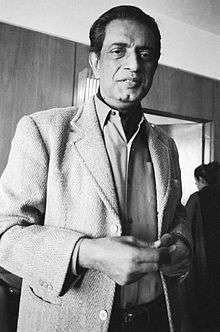Bengali Renaissance
The Bengali Renaissance or simply Bengal Renaissance, (Bengali: বাংলার নবজাগরণ; Banglār Nobojāgoroṇ) was a cultural, social, intellectual and artistic movement in Bengal region in the eastern part of the Indian subcontinent during the period of the British Indian Empire, from the nineteenth century to the early twentieth century dominated by Bengalis.[1]
| Part of a series on |
| Bengalis |
|---|
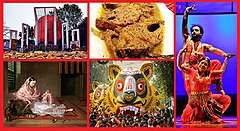 |
|
Bengali homeland |
|
Bengali culture
|
|
Bengali symbols |
Historian Nitish Sengupta describes the Bengal Renaissance as taking place from Raja Ram Mohan Roy (1772–1833) through Rabindranath Tagore (1861–1941).[2] According to historian Sumit Sarkar, nineteenth-century Bengali religious and social reformers, scholars, literary giants, journalists, patriotic orators and scientists were revered and regarded with nostalgia in the early and mid-twentieth century. In the early 1970s, however, a more critical view emerged[3]. "Few serious scholars could deny that nineteenth-century Bengal had fallen considerably short of the alleged Italian prototype", wrote Sarkar. Although in 1990 the "average educated Bengali" still admired the Bengali Renaissance, "most intellectuals who would like to consider themselves radical and sophisticated", no longer glorified the period.[4]
Background
The renaissance period after the Indian Rebellion of 1857 saw a magnificent outburst of Bengali literature. While Ram Mohan Roy and Iswar Chandra Vidyasagar were the pioneers, others like Bankim Chandra Chatterjee widened it and built upon it.[5]
The Tagore family, including Rabindranath Tagore, were leaders of this period and had a particular interest in educational reform.[6] Their contribution to the Bengal Renaissance was multi-faceted. Several members of the family, including Rabindranath, Abanindranath, Gaganendranath and Jyotirindranath Tagore, Asit Kumar Haldar and Jnanadanandini Devi have been associated with the movement.[7]
According to Nitish Sengupta, though the Bengal Renaissance was the "culmination of the process of emergence of the cultural characteristics of the Bengali people that had started in the age of Hussein Shah, it remained predominantly Hindu and only partially Muslim."[8] There were, nevertheless, examples of Muslim intellectuals such as Syed Ameer Ali, Mosharraf Hussain,[8]
Science and technology
During the Bengal Renaissance science was also advanced by several Bengali scientists such as Satyendra Nath Bose, Anil Kumar Gain, Prasanta Chandra Mahalanobis, Prafulla Chandra Ray, Debendra Mohan Bose, Jagadish Chandra Bose, Jnan Chandra Ghosh, Gopal Chandra Bhattacharya, Kishori Mohan Bandyopadhyay, Jnanendra Nath Mukherjee, Sisir Kumar Mitra, Upendranath Brahmachari and Meghnad Saha. Jagadish Chandra Bose (1858–1937) was a polymath: a physicist, biologist, botanist, archaeologist, and writer of science fiction.[9] He pioneered the investigation of radio and microwave optics, made very significant contributions to botany, and laid the foundations of experimental science in the Indian subcontinent.[10] He is considered one of the fathers of radio science,[11] and is also considered the father of Bengali science fiction. He also invented the crescograph.
Anil Kumar Gain (1919–1978) and Prasanta Chandra Mahalanobis (1893–1972) were leading mathematicians and statisticians of their time. Gain went on to found Vidyasagar University, while Mahalanobis laid the foundation of the Indian Statistical Institute.
- Jagadish Chandra Bose was one of the fathers of radio science.
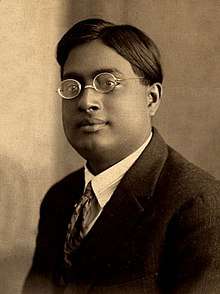 Satyendra Nath Bose was one of the pioneers of quantum mechanics.
Satyendra Nath Bose was one of the pioneers of quantum mechanics.
Arts
The Bengal School of Art was an art movement and a style of Indian painting that originated in Bengal and flourished throughout British India in the early 20th century. Also known as 'Indian style of painting' in its early days, it was associated with Indian nationalism (swadeshi) and led by Abanindranath Tagore.[12][13]
Following the influence of Indian spiritual ideas in the West, the British art teacher Ernest Binfield Havell attempted to reform the teaching methods at the Calcutta School of Art by encouraging students to imitate Mughal miniatures. This caused controversy, leading to a strike by students and complaints from the local press, including from nationalists who considered it to be a retrogressive move. Havell was supported by the artist Abanindranath Tagore.[14] Some prominent artists associated with the Bengal school include Nandalal Bose, Abanindranath Tagore and Gaganendranath Tagore, Asit Kumar Haldar, Kalipada Ghoshal, Sunayani Devi, and Beohar Rammanohar Sinha.
Literature
Rabindranath Tagore is the most influential literary figure of the movement. Tagore's English translation of a set of poems titled the Gitanjali won him the Nobel Prize for Literature in 1913. He was the first Asian to win this award.
Begum Rokeya is widely known for her work Sultana's Dream, which depicts a futuristic society of role reversal, in which men are locked away in seclusion, in a manner corresponding to the traditional Muslim practice of purdah for women.
According to historian Romesh Chunder Dutt:[15]
The conquest of Bengal by the English was not only a political revolution, but ushered in a greater revolution in thoughts and ideas, in religion and society ... From the stories of gods and goddesses, kings and queens, princes and princesses, we have learnt to descend to the humble walks of life, to sympathise with the common citizen or even common peasant … Every revolution is attended with vigour, and the present one is no exception to the rule. Nowhere in the annals of Bengali literature are so many or so bright names found crowded together in the limited space of one century as those of Ram Mohan Roy, Akshay Kumar Dutt, Isvar Chandra Vidyasagar, Isvar Chandra Gupta, Michael Madhusudan Dutt, Hem Chandra Banerjee, Bankim Chandra Chatterjee and Dina Bandhu Mitra. Within the three quarters of the present century, prose, blank verse, historical fiction and drama have been introduced for the first time in the Bengali literature.
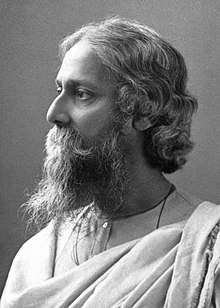 Rabindranath Tagore was a poet, philosopher and artist. He was awarded the Nobel Prize in Literature in 1913
Rabindranath Tagore was a poet, philosopher and artist. He was awarded the Nobel Prize in Literature in 1913 Kazi Nazrul Islam, the national poet of Bangladesh
Kazi Nazrul Islam, the national poet of Bangladesh
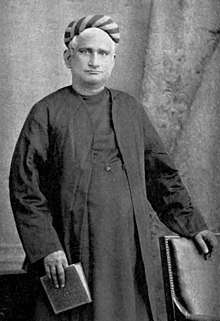

References
- Andrew Clinton Willford (1991). Religious Resurgence in British India: Vivekananda and the Hindu Renaissance. University of California, San Diego, Department of Anthropology.
- Nitish Sengupta (2001). History of the Bengali-speaking People. UBS Publishers' Distributors. p. 211. ISBN 978-81-7476-355-6.
The Bengal Renaissance can be said to have started with Raja Ram Mohan Roy (1775-1833) and ended with Rabindranath Tagore (1861-1941), although there were many other stalwarts thereafter embodying particular aspects of the unique intellectual and creative ferment.
- Dhar, Pulak Naranyan (1987). "Bengal Renaissance: A Study in Social Contradictions". Social Scientist. 15 (1): 26–45. doi:10.2307/3517400. ISSN 0970-0293.
- Sarkar, Sumit (1990). "Calcutta and the Bengal Renaissance". In Chaudhuri, Sukanta (ed.). Calcutta: The Living City. Volume I: The Past. Oxford University Press. pp. 95, 97. ISBN 978-0-19-563696-3.
- Nitish Sengupta (2001). History of the Bengali-speaking People. UBS Publishers' Distributors. p. 253. ISBN 978-81-7476-355-6.
- Kathleen M. O'Connell, "Rabindranath Tagore on Education", infed.org
- Deb, Chitra, pp 64-65.
- Nitish Sengupta (2001). History of the Bengali-speaking People. UBS Publishers' Distributors. p. 213. ISBN 978-81-7476-355-6.
- A versatile genius Archived 3 February 2009 at the Wayback Machine, Frontline 21 (24), 2004.
- Chatterjee, Santimay and Chatterjee, Enakshi, Satyendranath Bose, 2002 reprint, p. 5, National Book Trust, ISBN 8123704925
- Sen, A. K. (1997). "Sir J.C. Bose and radio science". Microwave Symposium Digest. IEEE MTT-S International Microwave Symposium. Denver, CO: IEEE. pp. 557–560. doi:10.1109/MWSYM.1997.602854. ISBN 0-7803-3814-6.
- "Bengal School". National Gallery of Modern Art, New Delhi. Archived from the original on 22 October 2018. Retrieved 13 February 2019.
- Dey, Mukul. "Which Way Indian Art?". chitralekha.org. Retrieved 13 February 2019.
- Cotter, Holland (19 August 2008). "'Rhythms of India' Exhibition at the Philadelphia Museum of Art: Indian Modernism Via an Eclectic, Elusive Artist". The New York Times. ISSN 0362-4331. Retrieved 13 February 2019.
- R. C. Dutt (1962) [First published 1877 as The Literature of Bengal]. Cultural Heritage of Bengal. (3rd ed). Punthi Pustak. p. 166–167, cited in Nitish Sengupta (2001). History of the Bengali-speaking People. UBS Publishers' Distributors. pp. 211–212. ISBN 978-81-7476-355-6.
Further reading
- Chatterjee, Pranab (2010). A Story of Ambivalent Modernization in Bangladesh and West Bengal: The Rise and Fall of Bengali Elitism in South Asia. Peter Lang. ISBN 9781433108204.
- Dasgupta, Subrata (2005). Twilight of the Bengal renaissance: R.K. Dasgupta & his quest for a world mind. the University of California: Dey's Publishing.
- Dasgupta, Subrata (2009). The Bengal Renaissance. Permanent Black. ISBN 978-8178242798.
- Dasgupta, Subrata (2011). Awakening: The Story of the Bengal Renaissance. Random House India. ISBN 978-8184001839.
- Dhar, Niranjan (1977). Vedanta and the Bengal Renaissance. the University of Michigan: Minerva Associates. ISBN 9780883868379.
- Fraser, Bashabi edited Special Issue on Rabindranath Tagore, Literary Compass, Wiley Publications. Volume 12, Issue 5, May 2015. See Fraser's Introduction pp. 161–172. ISSN 1741-4113.
- Kabir, Abulfazal M. Fazle (2011). The Libraries of Bengal, 1700-1947: The Story of Bengali Renaissance. Promilla & Co. Publishers. ISBN 978-8185002071.
- Kopf, David (1969). British Orientalism and the Bengal Renaissance. University of California Press. ISBN 978-0520006652.
- Kumar, Raj (2003). Essays on Indian Renaissance. Discovery Publishing House. ISBN 978-81-7141-689-9.
- Marshall, P. J. (2006). Bengal: The British Bridgehead: Eastern India 1740-1828 (The New Cambridge History of India). Cambridge University Press. ISBN 978-0521028226.
- Mittra, Sitansu Sekhar (2001). Bengal's Renaissance. Academic Publishers. ISBN 9788187504184.
- Pal, Bipin Chandra; Cakrabartī, Jagannātha (1977). Studies in the Bengal renaissance. the University of California: National Council of Education, Bengal.
- Sastri, Sivanath. A History of the Renaissance in Bengal: Ramtanu Lahiri, Brahman and Reformer, London: Swan, Sonnenschein (1903); Kolkata: Renaissance (2002).
- Sastri, Sibnath (2008). Ramtanu Lahiri, Brahman and Reformer: A History of the Renaissance in Bengal. BiblioLife. ISBN 978-0559841064.
- Sen, Amit (2011). Notes on the Bengal Renaissance. Nabu Press. ISBN 978-1179501390.
- Travers, Robert (2007). Ideology and Empire in Eighteenth-Century India: The British in Bengal. Cambridge University Press. ISBN 978-0521059688.
External links
| Wikimedia Commons has media related to Bengali renaissance. |
- Copf, David (2012). "Bengal Renaissance". In Islam, Sirajul; Jamal, Ahmed A. (eds.). Banglapedia: National Encyclopedia of Bangladesh (Second ed.). Asiatic Society of Bangladesh.
